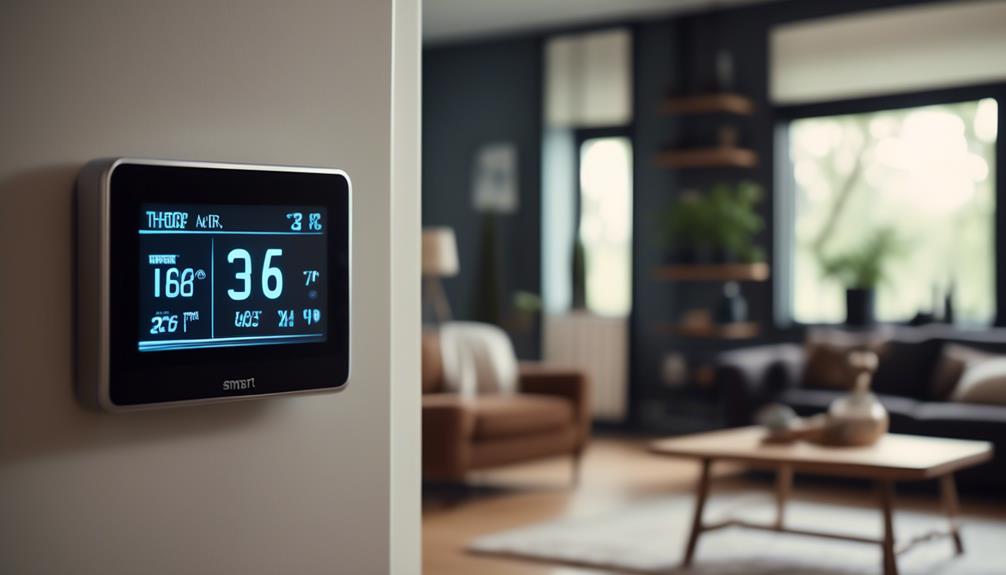Imagine walking into a warm, cozy home on a chilly winter day, feeling a sense of relief as the heat envelops you. Now, picture the happiness you would feel knowing that this comfort doesn't come at the expense of high energy bills.
Smart thermostats have been touted as a solution to help you save money on your energy bills, but can they really deliver on this promise? In this discussion, we will explore the effectiveness of smart thermostats in reducing energy costs and uncover the potential advantages they offer.
So, let's dive in and discover whether these devices are truly worth the investment.
Key Takeaways
- Smart thermostats utilize motion sensors and geo-fencing to adjust temperature based on occupancy, optimizing comfort and energy conservation.
- By programming temperature adjustments during sleep or when the house is typically empty, smart thermostats can potentially save up to 10% on energy bills.
- The app-based interfaces of smart thermostats provide user-friendly control and monitoring, allowing for remote access and temperature adjustments from anywhere.
- Smart thermostats meeting Energy Star criteria can save an average of 8% on utility bills, and additional features like energy reports and reminders further maximize energy savings.
How Smart Thermostats Work
Smart thermostats work by utilizing motion sensors and geo-fencing to determine when your house is empty and adjusting the temperature accordingly. These advanced devices can turn off the heat and AC more frequently than regular thermostats without sacrificing comfort. By programming the thermostat to adjust the temperature when you're asleep or when the house is typically empty, you can save up to 10% on your heating and cooling bills.
The motion sensors detect movement within the house, signaling that someone is present. On the other hand, geo-fencing uses your smartphone's GPS to determine when you're away from home. Once the smart thermostat detects that the house is empty, it will automatically adjust the temperature to save energy.
In addition to these features, smart thermostats also offer app-based interfaces that are more user-friendly compared to regular programmable thermostats. With these interfaces, you can easily control and monitor the temperature of your home from anywhere, giving you the freedom to manage your energy usage efficiently.
Furthermore, some smart thermostats are equipped with learning capabilities. They analyze your habits and usage patterns to automatically set a schedule that optimizes energy consumption. This eliminates the need for manual programming, making it even easier to save money on your energy bills.
Benefits of Smart Thermostats
By utilizing motion sensors, geo-fencing, and app-based interfaces, smart thermostats offer a range of benefits that can help you save money on your energy bills. Here are four ways smart thermostats can help you save money:
- Optimized Temperature Control: Smart thermostats can learn your temperature preferences and adjust accordingly, ensuring that your home is always at the ideal temperature when you're there and conserving energy when you're away.
- Energy Usage Insights: Smart thermostats provide detailed energy usage reports, allowing you to track your consumption patterns and identify opportunities for energy-saving adjustments. This empowers you to make informed decisions that can lead to significant savings on your energy bills.
- Remote Access and Control: With app-based interfaces, you can control your smart thermostat from anywhere using your smartphone. This means that if you forget to adjust the temperature before leaving the house, you can do so remotely, preventing unnecessary energy consumption.
- Integration with Other Smart Devices: Smart thermostats can integrate with other smart devices in your home, such as smart lighting or smart plugs. This integration allows for coordinated energy-saving actions, such as turning off lights and appliances when you leave the house, further reducing your energy bills.
With these benefits, smart thermostats offer an effective way to save money on your energy bills while maintaining optimal comfort levels in your home.
Energy Savings With Smart Thermostats
Save money on your energy bills with the help of smart thermostats and their energy-saving features. Studies have shown that smart thermostats meeting Energy Star criteria can save an average of 8% on utility bills. How do they achieve these energy savings? Well, smart thermostats are equipped with motion sensors and geo-fencing capabilities, allowing them to determine when the house is empty and adjust the temperature accordingly. By programming the thermostat to adjust the temperature when you're asleep or when the house is typically empty, you can save up to 10% on your heating and cooling bills.
But the energy savings don't stop there. Smart thermostats offer additional features that can help you save even more. They provide system run reports, energy-saving reminders, and connectivity with utility programs. These features allow you to track your energy usage and make adjustments accordingly, ensuring that you're maximizing your energy savings.
Features of Smart Thermostats
To further enhance your energy savings, smart thermostats offer a range of features that provide user-friendly control, optimize energy efficiency, and provide valuable insights into your energy usage. Here are four key features of smart thermostats:
- Motion sensors and geo-fencing: Smart thermostats use motion sensors and geo-fencing technology to determine occupancy and adjust temperatures accordingly. This means that when you leave the house, the thermostat can automatically adjust the temperature to save energy, and when you return, it can bring the temperature back to your preferred setting.
- App-based interfaces: Smart thermostats often come with app-based interfaces that allow you to control and schedule your thermostat remotely. This means you can adjust the temperature from anywhere, ensuring that you aren't wasting energy when you aren't at home.
- Learning capabilities: Some smart thermostats have learning capabilities that automatically set schedules based on your usage patterns. This feature optimizes energy efficiency by adjusting temperatures based on your habits, saving you money on your energy bills.
- Energy reports and reminders: Smart thermostats can provide you with energy reports that show your usage patterns and suggest ways to save energy. They can also send you reminders to change air filters or schedule maintenance, helping to keep your system running efficiently.
With these features, smart thermostats offer convenient and effective ways to save money on your energy bills while maintaining a comfortable home environment.
Tips for Maximizing Energy Savings
To maximize energy savings with your smart thermostat, start by programming temperature schedules that adjust when you're asleep or away, potentially saving up to 10% on heating and cooling bills.
Take advantage of the smart features offered, such as app-based interfaces that make temperature adjustments easy and provide energy-saving reminders.
Additionally, monitor your energy usage through features like motion sensors and system run reports to optimize efficiency and reduce costs.
Programming Temperature Schedules
Create personalized temperature schedules on your smart thermostat to maximize energy savings.
Here are four tips to help you save money on your energy bills:
- Take advantage of motion sensors and geo-fencing: Smart thermostats can detect when you're not at home and adjust the temperature accordingly. This feature ensures that energy isn't wasted on heating or cooling an empty house.
- Use app-based interfaces for easy programming: Unlike regular programmable thermostats, smart thermostats offer user-friendly interfaces that allow you to easily set temperature schedules. You can adjust the settings from anywhere using your smartphone or tablet.
- Consider learning thermostats: These devices automatically learn your habits and usage patterns and create a temperature schedule based on that information. This way, you don't have to manually program the thermostat.
- Explore additional features: Smart thermostats often come with features like system run reports, energy-saving reminders, and connectivity with utility programs. These features provide valuable insights and help you make informed choices to save money on your energy bills.
Utilizing Smart Features
Maximize your energy savings by utilizing the smart features of your smart thermostat. Set temperature schedules based on occupants' sleeping and away times for potential 10% savings.
Take advantage of features like motion sensors and geo-fencing to automatically adjust the temperature when the house is empty. These features ensure that you aren't wasting energy on heating or cooling an unoccupied space.
Additionally, utilize app-based interfaces for user-friendly control and energy-saving reminders. This allows you to easily monitor and adjust your thermostat settings from anywhere, ensuring optimal energy efficiency.
Consider opting for learning thermostats that automatically set schedules based on your usage patterns, further increasing your energy savings.
Furthermore, take advantage of system run reports and connectivity with utility programs for additional energy-saving benefits.
Monitoring Energy Usage
By monitoring your energy usage, you can further maximize your savings with a smart thermostat. Here are four tips for maximizing energy savings through monitoring:
- Programming your thermostat: Take advantage of the ability to program your smart thermostat to adjust the temperature when you're asleep or when the house is typically empty. This can save up to 10% on heating and cooling bills.
- Motion sensors and geo-fencing: Smart thermostats use motion sensors and geo-fencing technology to determine when the house is empty and adjust the temperature accordingly. This contributes to energy savings by avoiding unnecessary heating or cooling.
- Additional features: Smart thermostats offer features like system run reports and energy-saving reminders. These features help you stay on top of your energy usage and make adjustments as needed to enhance energy efficiency.
- Remote temperature sensors: Some smart thermostats come with remote temperature sensors that allow you to achieve the right temperatures in specific rooms. This not only contributes to energy savings but also enhances comfort.
Compatibility of Smart Thermostats
Are smart thermostats compatible with all HVAC systems?
While smart thermostats offer many benefits for saving money on energy bills, it's important to consider their compatibility with your existing HVAC system. Some smart thermostats may not work with older systems that lack a C-wire, which is required for power supply. To determine compatibility, ratings and specifications often indicate whether the thermostat is suitable for legacy setups.
However, if your HVAC system is compatible, smart thermostats can provide significant savings. They allow for remote access and control through smartphone apps, enabling you to adjust temperature settings even when you're away from home. This means you can optimize energy usage and save money by adjusting the temperature based on your schedule or when no one is home.
Moreover, smart thermostats can integrate with virtual assistants like Amazon Alexa and Google Assistant, allowing you to control them through voice commands. This hands-free approach adds convenience and ease of use to your energy-saving efforts.
Additionally, smart thermostats have learning capabilities, which means they can adapt to your behaviors and habits over time. They can learn your schedule and automatically adjust temperature settings accordingly, optimizing energy usage and reducing your energy bills.
Cost of Smart Thermostats
When considering the cost of smart thermostats, there are a few key points to keep in mind.
First, the price of smart thermostats can vary depending on the brand and features, ranging from around $100 to $300.
However, it's important to note that these devices can lead to significant energy savings, with an average of 8% on utility bills.
This means that the payback period for the investment can be relatively short, especially in regions with extreme temperatures or high energy prices.
Price of Smart Thermostats
Smart thermostats offer a range of benefits, but how much do they actually cost? Here are four key points to consider:
- Price range: Smart thermostats can range in price from around $100 to $250, depending on the brand and features.
- Potential savings: While the upfront cost may seem high, smart thermostats can save you money on your energy bills. On average, they can save users about 8% on their utility bills, which can amount to around $50 per year.
- Additional features: Smart thermostats offer more than just energy savings. They provide features such as system run reports, energy-saving reminders, and connectivity with utility programs, enhancing your overall experience and convenience.
- Learning capabilities: Some smart thermostats have the ability to learn your habits and usage patterns, automatically setting a schedule that maximizes energy efficiency without sacrificing comfort.
Considering the potential savings and additional features, investing in a smart thermostat can be a smart choice to save money on your energy bills.
Energy Savings Potential
Smart thermostats can save you an average of 8% on your utility bills, resulting in potential annual savings of around $50. These devices turn off the heat and AC more frequently than regular thermostats without sacrificing comfort. They use motion sensors and geo-fencing to determine when the house is empty and adjust the temperature accordingly.
By programming the thermostat to adjust the temperature when you're asleep or when the house is typically empty, you can save up to 10% on heating and cooling bills. Keep in mind that the savings may be higher in regions with extreme temperatures or high energy prices.
Payback Period Estimation
To estimate the payback period for smart thermostats, it's essential to consider factors such as energy usage, regional climate, and utility rates. Here are four key considerations for estimating the payback period:
- Initial investment cost: Smart thermostats typically range in price from $100 to $300, depending on the brand and features. The initial cost of the thermostat will impact the overall payback period.
- Expected annual energy savings: Smart thermostats can save homeowners an average of 10% to 15% on heating and cooling costs. The amount of energy savings will vary based on factors like lifestyle, home size, and climate.
- Regional climate: Homes in regions with extreme temperatures, such as very hot or very cold climates, may see higher energy savings with a smart thermostat, leading to a shorter payback period.
- Utility rates: The cost of energy varies by location and utility provider. Areas with higher energy prices may experience a faster payback period due to greater potential savings.
Considering these factors will help you estimate the payback period for a smart thermostat and determine whether the cost savings on energy bills make it a worthwhile investment.
Real-Life Examples of Energy Bill Savings
Real-life examples demonstrate the significant energy bill savings achieved through the use of smart thermostats. Smart thermostats meeting Energy Star criteria save users an average of 8% on their utility bills. This means that a household with an average energy bill of $150 per month could save about $144 per year. Even in low-income, multifamily housing, smart thermostats have been shown to achieve similar savings. These savings can amount to about $50 per year, but may be even higher in regions with extreme temperatures or high energy prices.
Smart thermostats are able to achieve these savings by turning off the heat and AC more frequently than regular thermostats, without sacrificing comfort. They use features like motion sensors and geo-fencing to determine when the house is empty and adjust the temperature accordingly. By doing so, they prevent unnecessary energy usage when no one is home.
Frequently Asked Questions
Do Smart Thermostats Really Save Energy?
Smart thermostats can save you money on energy bills. They have the potential for significant savings by improving energy efficiency. Real world results show that users can save up to 10% on heating and cooling costs.
Is There a Downside to Smart Thermostats?
Yes, there are potential privacy concerns with smart thermostats, compatibility issues with older HVAC systems, and a learning curve to navigate. However, the potential energy and cost savings make them worth considering.
Is a Smart Thermostat Worth It if You Are Always Home?
If you're always home, a smart thermostat may not save as much on energy bills. However, it can still provide temperature control and convenience. Consider consulting with HVAC professionals to assess cost effectiveness.
Does Adjusting the Thermostat up or Down Really Save Money on Energy Bills?
Adjusting your thermostat up or down can indeed save you money on energy bills. By programming it to adjust when you're asleep or away, you can increase energy efficiency and achieve significant cost savings.
Are Smart Thermostats as Accurate in Saving Money on Energy Bills as Fitness Trackers Are in Estimating Calorie Expenditure?
Smart thermostats are gaining popularity for their energy-saving potential, but are they as accurate as fitness tracker calorie estimation accuracy? While smart thermostats can help reduce energy costs, fitness trackers have been known to have varying levels of accuracy in estimating calorie expenditure.
Conclusion
So, can smart thermostats really save you money on energy bills?
The answer is a resounding yes! Studies have shown that these innovative devices can save users an average of 8% on their utility bills. That's like putting an extra $50 back in your pocket each year.
By using motion sensors and geo-fencing, smart thermostats adjust the temperature based on occupancy, ensuring comfort while maximizing energy savings.
So, go ahead and make the smart choice for your wallet and the environment with a smart thermostat.





